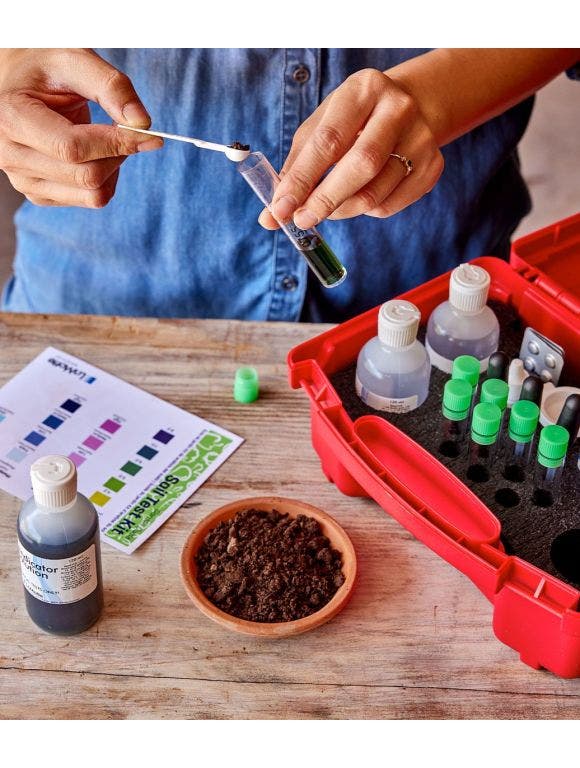


Soil vitality is key to growing healthy, thriving plants in your garden. While often overlooked, soil pH is not only important for the soil microbiota but for plants as well. But how do you test soil pH, and why is it important to do so? Learn more about soil pH and how it can affect your garden.
What Is Soil pH?
pH is defined as the measure of acidity or alkalinity (sometimes referred to as basicity) of a solution. The pH of a solution ranges from 0 to 14, with 0 being very acidic, 7 being neutral and 14 being very alkaline. For comparison, lemons have a pH of about 2, while antacid tablets register a pH of about 10.
The type of soil, amount of rainwater and amount of organic matter present in soil are perhaps the greatest factors for determining a soil's pH. Soil is gradually acidified where rains are more frequent and organic matter accumulates. Conversely, in locations with less rainfall and poor permeability, soil tends to become more alkaline.
Why Is It Important to Test Soil pH?
pH can help you determine what plants will grow and thrive in your particular soil. This is because, in their native environments, plants have adapted to specific pH levels for optimal nutrient absorption. Before planting in a new location, it's often beneficial to test your soil's pH to accurately determine which plants will do well and what soil amendments you'll need to add prior to planting.
How Do You Test Soil pH?
Testing your soil's pH is easy and inexpensive. The best time to test your soil is before you begin planting. Different sections of the yard can have varying pH levels, so it's best to test each section for a full analysis of the landscape.
The easiest way to test is by purchasing an electronic soil tester. To use this small device, start by collecting soil from about 2 inches below the surface and remove any debris. Make sure the soil is room temperature. Add distilled water to the soil until it turns to mud, then insert the probes. After about one minute, note the reading. For this method, only use distilled water with a neutral pH of 7 to avoid impacting the soil's pH. Clean the soil tester probes after each use.
If you're a new homeowner or are looking for a more detailed analysis of your soil, you might want to opt for a soil testing kit. In addition to testing pH, this kit also includes testing for the three macronutrients: nitrogen, phosphorus and potassium. Alternatively, you can contact your county extension service for soil testing services. These additional tests give you a more complete picture of your soil's nutrient load and vitality.
What Impact Does Soil pH Have on Your Garden?
The long-term impact of soil pH on your garden largely depends on the plants you'd like to grow.
Over thousands of years, plants have adapted to specific soils. Some plants have adapted to more acidic soils, while others have adapted to more alkaline soils. Your soil's pH range will greatly determine what will grow well in your garden. And while it's true that many plants are relatively flexible in regard to pH, some plants that require specific pH ranges need to stay in this range to thrive. This is because these plants are unable to absorb nutrients properly outside of their range. In other words, the needed nutrients are in the soil, but because of the pH level, the plants aren't able to uptake and utilize them properly. Knowing your soil's pH is key to planting the right plants or amending the soil accordingly.
Does pH Fluctuate Throughout the Season or From Year to Year?
While the changes might be slight, pH does fluctuate throughout the year and is especially evident in places with pronounced seasonal changes. During the summer when plants are growing rapidly, rain is prevalent and organic matter is quickly breaking down, pH tends to decrease. Coupled with the use of fertilizers, this drop can be difficult for some plants that prefer a higher range.
Over time, many home garden soils naturally become more acidic. This change will be most noticeable in indicator plants such as 'Nikko Blue' hydrangeas. In this cultivar, you'll notice pink flowers in more alkaline soils and blue to purple flowers in more acidic soils. If your flowers begin as bright pink and begin to darken to blue or purple, that's an indication that your soil is becoming more acidic.
Do Different Plants Need Different Soil pH Levels?
As mentioned, many plants require specific pH levels to absorb nutrients and thrive. Classic garden favorites such as azaleas, rhododendrons and camellias, for example, all require more acidic soils. If a plant is grown in soil outside of its preferred pH range, issues can occur due to a lack of nutrient absorption, including chlorosis (loss of color between veins), stunted growth and leaf spotting.
How Do You Change Soil pH?
You can modify your soil to become more acidic or more alkaline by including soil additives.
To lower the pH and create more acidic soil, you can use a few methods. Adding organic material to the soil, specifically compost, peat or sphagnum, will slowly decrease the soil's pH. This method takes time and naturally increases soil health and microbiota while creating a more acidic composition. However, to quickly decrease pH, you can use products that contain sulfur compounds, such as Burpee's Natural Organic Azalea, Camellia and Rhododendron plant food.
If your goal is to raise the soil's pH, one of the best ways is to add garden lime. Composed largely of calcium, adding lime to the soil will increase the pH. You can safely add products such as Espoma's Organic Garden Lime to the soil as directed on the packaging without causing any negative side effects.
Understanding soil pH is key to creating a lush and vibrant garden full of thriving plants. From deciding what to plant and how to amend the soil to navigating pests and disease, pH plays a large role in your garden's overall well-being.
For more information on how you can improve your soil, check out the article Understanding the Importance of Soil.



